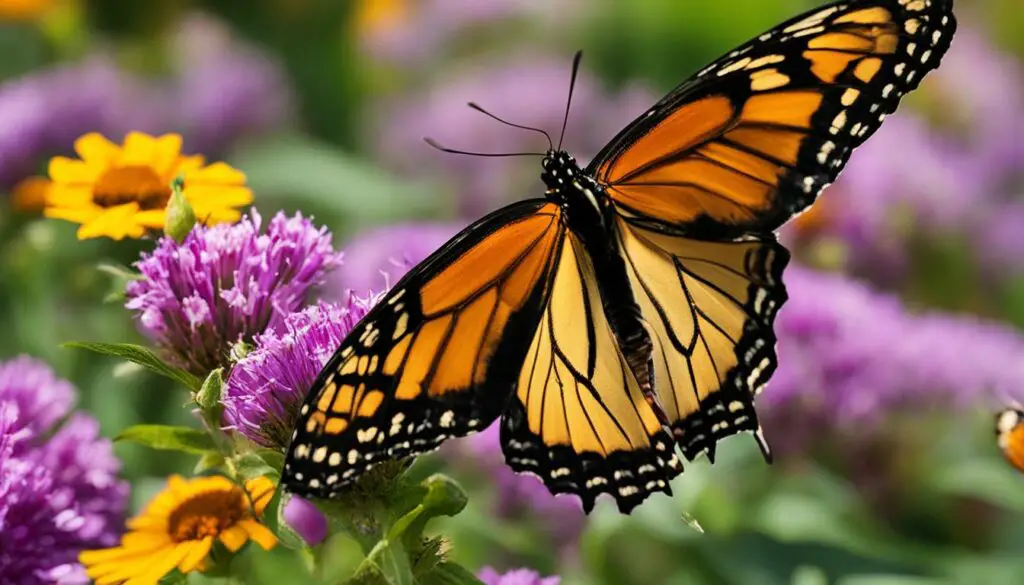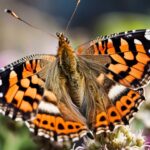Are you looking to attract butterflies to your garden? Want to create a butterfly-friendly oasis that’s sure to delight both your eyes and the butterflies? Look no further! In this article, I’ll share with you some extraordinary butterfly-friendly nectar plant suggestions that will make your garden a haven for these beautiful creatures.
When it comes to attracting butterflies, it’s all about the plants. Butterflies are irresistibly drawn to nectar-rich flowers, and by incorporating these butterfly garden plants into your landscape, you can create a paradise that will be buzzing with color and activity.
Imagine the sight of vibrant butterflies flitting from flower to flower, sipping nectar and bringing joy to your garden. By choosing the right plants, you can create a haven where butterflies can thrive, pollinate, and enchant you with their graceful presence.
So, whether you’re a seasoned butterfly enthusiast or just starting out, these butterfly-friendly nectar plants are sure to attract these winged pollinators to your garden. Get ready to enjoy the beauty and magic of butterflies up close!
Key Takeaways:
- Attract butterflies to your garden with nectar-rich flowers.
- Create a butterfly-friendly oasis by incorporating these extraordinary plants.
- Enjoy the sight of vibrant butterflies flitting from flower to flower in your garden.
- Support butterfly populations by providing nectar-rich plants.
- Enhance the natural beauty of your outdoor space with a butterfly-friendly garden.
Buddleia Selections
When it comes to attracting butterflies to your garden, one plant that should be at the top of your list is the butterfly bush, also known as Buddleia. This shrub is a favorite among butterflies and is typically covered in these beautiful insects throughout the summer. With its fragrant flowers in shades of blue, purple, and white, the butterfly bush creates a visual spectacle that is hard to resist.
Buddleia grows best in full sun and moist, well-drained soil. It can reach an impressive size, with some varieties growing up to 10 feet tall and 15 feet wide. This makes it a great choice for creating a dramatic focal point in your garden. Buddleia selections are recommended for zones 5-9, so be sure to check the specific growing conditions for your area.
For a visually stunning butterfly-friendly garden, consider pairing your butterfly bush with Mexican sunflower. These two plants complement each other beautifully and will create a vibrant display that is sure to attract butterflies and other pollinators to your garden. Mexican sunflower, or Tithonia rotundifolia, is another nectar-rich plant that butterflies find irresistible. It grows best in full sun and well-drained soil, and its bold orange flowers will provide a striking contrast to the butterfly bush’s blooms.
Table: Buddleia Selections
| Variety | Color | Height | Spread | Zones |
|---|---|---|---|---|
| Blue Chip | Blue | 2-3 feet | 2-3 feet | 5-9 |
| Miss Molly | Red | 4-5 feet | 4-5 feet | 5-9 |
| Pink Delight | Pink | 6-8 feet | 6-8 feet | 5-9 |
| White Profusion | White | 5-6 feet | 5-6 feet | 5-9 |
With its stunning blooms and ability to attract butterflies, the butterfly bush is a must-have for any butterfly garden. By selecting the right Buddleia varieties and pairing them with other butterfly-friendly plants, you can create a garden that is not only visually appealing but also a haven for these beautiful creatures.
Phlox Paniculata
Phlox paniculata is a stunning butterfly-friendly plant that adds vibrant color to any garden. With its clusters of red, pink, lavender, salmon, or white blooms, it is a favorite among both butterflies and humans. The fragrance of the flowers is irresistible, attracting butterflies from far and wide.
Growing conditions for Phlox paniculata are quite simple. It thrives in full sun and well-drained soil, making it suitable for a variety of garden environments. It can reach a height of up to 4 feet, creating a beautiful backdrop or focal point in your butterfly garden.
When selecting companion plants for Phlox paniculata, consider pairing it with purple coneflower. These two plants thrive in similar growing conditions and their colors complement each other beautifully. However, it’s important to note that Phlox paniculata is prone to powdery mildew, so it’s best to look for disease-resistant varieties.
Companion Plants for Phlox Paniculata:
Here are some companion plants that pair well with Phlox paniculata:
- Purple Coneflower (Echinacea purpurea)
- Black-eyed Susan (Rudbeckia)
- Butterfly Weed (Asclepias tuberosa)
- Joe Pye Weed (Eupatorium)
These plants not only complement Phlox paniculata in terms of growing conditions but also attract a variety of butterfly species, creating a diverse and beautiful butterfly garden.
| Plant | Height | Growing Conditions | Companion Plants |
|---|---|---|---|
| Phlox paniculata | Up to 4 feet | Full sun, well-drained soil | Purple Coneflower, Black-eyed Susan, Butterfly Weed, Joe Pye Weed |
Asclepias Tuberosa: A Haven for Monarch Butterflies
When it comes to attracting monarch butterflies, one plant stands out above the rest – Asclepias tuberosa, also known as butterfly weed. This vibrant flowering perennial is a favorite of both adult monarchs, who feast on its nectar-rich orange flowers, and caterpillars, who rely on its leaves as a food source. With its striking beauty and ecological significance, Asclepias tuberosa is a must-have addition to any butterfly-friendly garden.
One of the key factors in successfully growing Asclepias tuberosa is providing the right growing conditions. This plant thrives in full sun and well-drained soil, making it an ideal choice for gardens that receive plenty of direct sunlight. Additionally, Asclepias tuberosa is suitable for a wide range of USDA hardiness zones, from zone 4 to 9, making it accessible to butterfly enthusiasts across the United States.
When planning a butterfly garden with Asclepias tuberosa, consider pairing it with companion plants that enhance its visual appeal and attract even more butterflies. One excellent companion plant is liatris, a tall perennial with purple flowers that monarchs also love. Together, these two plants create a stunning combination that will surely catch the eye of both butterflies and human observers.
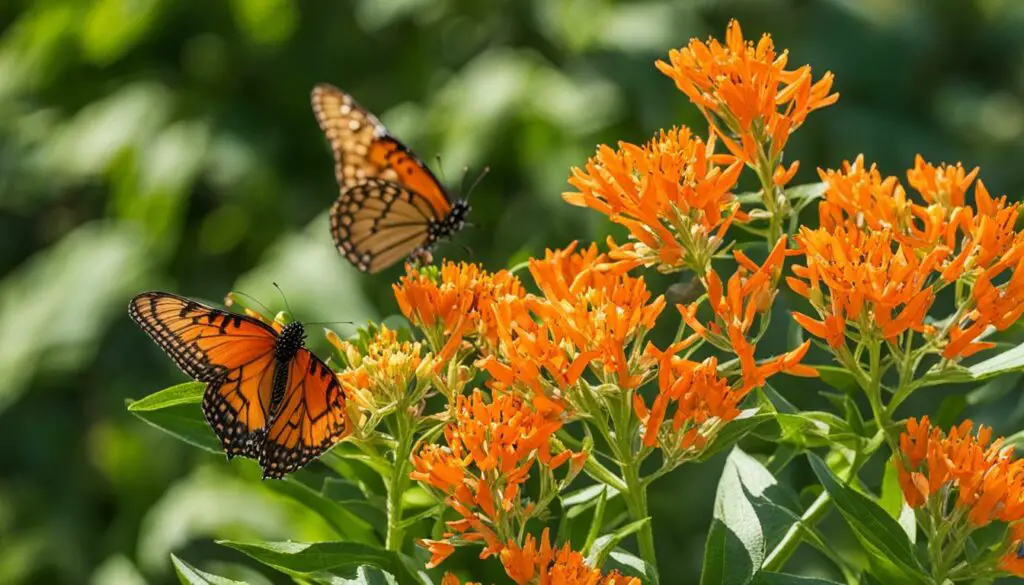
The Beauty and Significance of Monarch Butterflies
Monarch butterflies are not only beautiful to behold but also play a crucial role in the ecosystem as pollinators. Their long-distance migration from North America to Mexico is a remarkable feat of endurance and navigation, captivating both scientists and nature enthusiasts alike. However, monarch populations have been declining in recent years due to loss of habitat and other factors, making it more important than ever to create welcoming spaces for these iconic butterflies.
| Key Features of Asclepias Tuberosa | Growing Conditions for Asclepias Tuberosa |
|---|---|
|
|
“Butterfly weed, or Asclepias tuberosa, is not only a striking addition to any garden but also provides crucial habitat and food for monarch butterflies. By incorporating this plant into your butterfly-friendly garden, you can play a vital role in supporting monarch populations and enjoying the beauty of these majestic creatures up close.” – Butterfly enthusiast
Creating a butterfly garden with Asclepias tuberosa is a fulfilling and rewarding experience. Not only will you be providing a haven for monarch butterflies, but you will also be contributing to their conservation. So why not welcome these enchanting creatures into your outdoor space and witness the magic of monarchs in action?
Aster Selections
Aster is a top plant for the fall garden, with colorful flowers in shades of blue, purple, pink, red, and white. It not only provides nectar for fall butterflies but also serves as a food source for Pearl Crescent caterpillars. Aster grows best in full sun and moist, well-drained soil. Depending on the type, it can reach a height of up to 5 feet. Aster selections are recommended for zones 3-8.
For a beautiful combination, you can grow it with bloody geranium, as their colors complement each other. The vibrant blooms of aster and the deep red flowers of bloody geranium create a visually stunning contrast in the garden. Both plants share similar growing conditions and will thrive together.
“Asters are like the grand finale of the butterfly garden. They provide the perfect late-season nectar source for butterflies, and the caterpillars of Pearl Crescent butterflies love to munch on their leaves. It’s a win-win situation for nature and us gardeners!” – Gardening enthusiast
Butterfly-Friendly Companion Plants for Asters
- Bloody Geranium (Geranium sanguineum): This perennial plant features deep red flowers that beautifully complement the colorful blooms of asters. It grows well in full sun and well-drained soil, making it a perfect companion for asters.
- Goldenrod (Solidago): Goldenrod is a late-summer bloomer that provides nectar for butterflies. It has yellow flowers that create a stunning contrast when planted alongside asters.
- Joe Pye Weed (Eupatorium): Joe Pye Weed is a tall perennial with clusters of dusty-pink flowers. It attracts large butterflies like swallowtails and complements the height of asters.
By incorporating these butterfly-friendly aster selections into your garden, you can create a haven for butterflies and enjoy the beauty of these winged pollinators up close. The vibrant blooms of asters, along with their attractive companion plants, will not only attract butterflies but also add color and visual interest to your garden throughout the fall season.
| Plant | Height | Growing Conditions | Zones | Companion Plants |
|---|---|---|---|---|
| Aster selections | Up to 5 feet | Full sun, moist, well-drained soil | 3-8 | Bloody Geranium, Goldenrod, Joe Pye Weed |
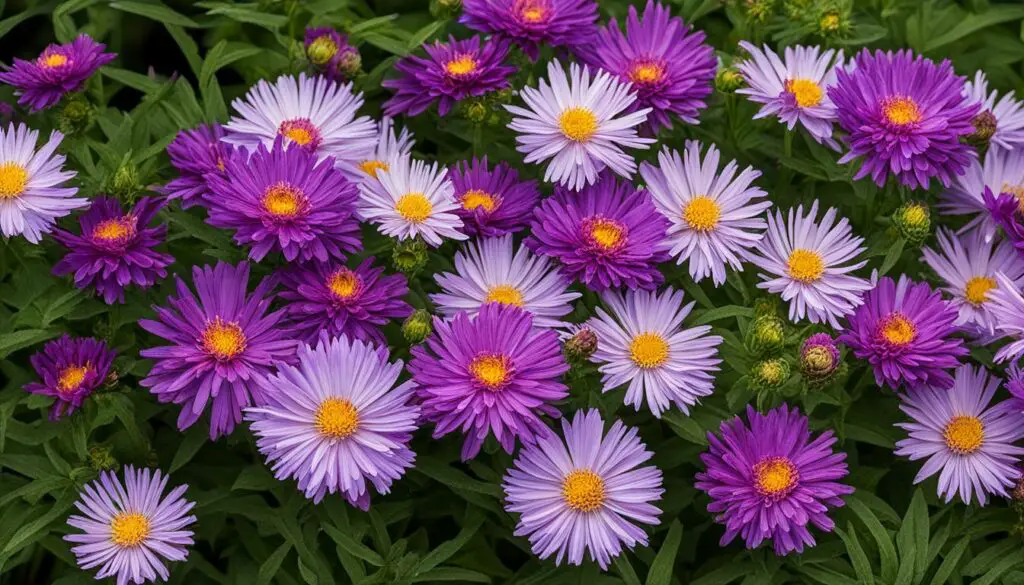
Mexican Sunflower (Tithonia Rotundifolia)
If you’re looking to add a burst of vibrant color to your butterfly garden, look no further than the Mexican sunflower, also known as Tithonia Rotundifolia. This stunning plant is known for its bold orange flowers that attract butterflies with their irresistible nectar. With its tall stature and nonstop blooming, the Mexican sunflower is sure to be a showstopper in your garden.
When it comes to growing conditions, the Mexican sunflower thrives in full sun and well-drained soil. It’s a relatively low-maintenance plant that can reach a height of up to 6 feet, providing a dramatic backdrop for your garden. Its long blooming period and drought tolerance make it a great choice for those looking to create a xeric butterfly garden.
To enhance the beauty of your Mexican sunflower and create a visually stunning display, consider pairing it with companion plants. One excellent choice is South American verbena, which has similar growing conditions and will complement the bold orange flowers of the Mexican sunflower. The combination of these two plants will create a vibrant and attractive focal point in your butterfly garden.
| Plant | Growing Conditions | Companion Plants |
|---|---|---|
| Mexican Sunflower | Full sun, well-drained soil | South American verbena |
The Mexican sunflower is a favorite among butterflies for its abundant nectar supply. Its bright orange flowers are particularly attractive to various butterfly species, making it a must-have for any butterfly enthusiast. By incorporating this stunning plant into your garden, you’ll not only attract butterflies but also add a touch of bold beauty to your outdoor space.
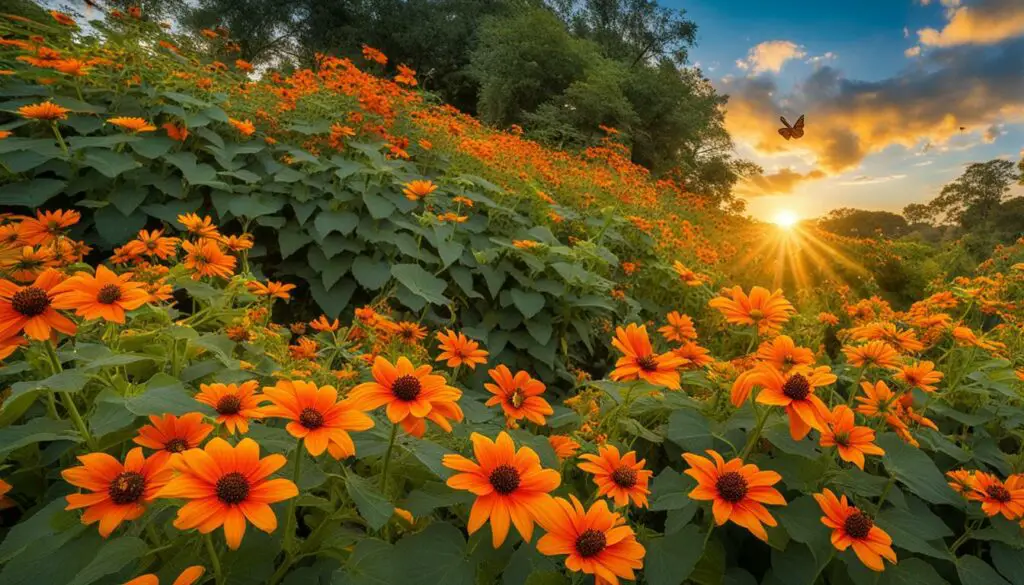
Verbena Bonariensis: Growing Conditions, Companion Plants, and Lavender-Purple Blooms
I adore Verbena bonariensis in my butterfly garden. This stunning plant not only adds a pop of color to my landscape with its lavender-purple blooms but also attracts countless butterflies with its nectar-rich flowers. If you want to create a beautiful and butterfly-friendly garden, Verbena bonariensis is a must-have.
Growing Verbena bonariensis is relatively easy. It thrives in full sun and well-drained soil, making it a perfect choice for sunny garden beds or containers on your patio. With its tall and slender stems, this plant can reach a height of up to 6 feet, creating a striking visual display in your garden.
When it comes to companion plants, I highly recommend pairing Verbena bonariensis with yarrow. Yarrow is a heat and drought-resistant plant that complements the lavender-purple blooms of Verbena bonariensis beautifully. With its flat clusters of blooms in various shades, yarrow adds even more visual interest to your butterfly garden.
“The combination of Verbena bonariensis and yarrow creates a vibrant and attractive combination that is irresistible to butterflies.” – Me
| Plant | Growing Conditions | Height |
|---|---|---|
| Verbena bonariensis | Full sun, well-drained soil | Up to 6 feet |
| Yarrow | Full sun, well-drained soil | 1-4 feet |
By incorporating Verbena bonariensis into your garden and pairing it with yarrow, you create a dynamic duo that will not only attract butterflies but also add beauty and charm to your outdoor space. So why wait? Start planting Verbena bonariensis and create a butterfly paradise in your own backyard.
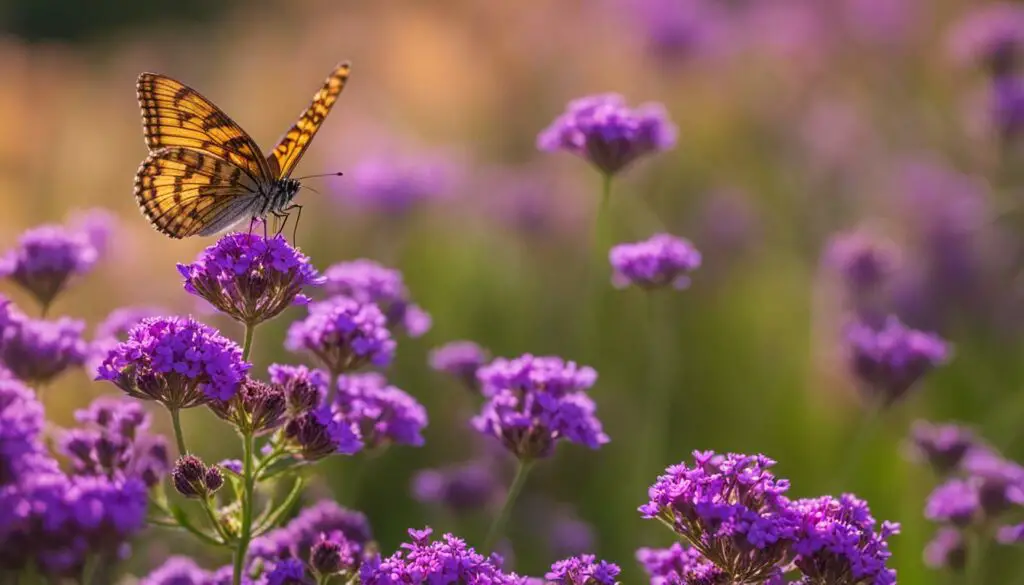
Stay tuned for the next section, where we’ll explore another butterfly-friendly nectar plant that will bring even more beauty and joy to your garden.
Zinnia Selections
Zinnias are a popular choice for attracting butterflies to your garden due to their vibrant colors and nectar-rich blooms. These beautiful flowers come in an endless range of colors, from bold reds and oranges to soft pinks and purples, making them a versatile and eye-catching addition to any butterfly-friendly garden.
To grow zinnias successfully, provide them with full sun and well-drained soil. They prefer warm weather and thrive in hot summer temperatures. It’s important to water them regularly, especially during dry periods, to ensure they stay healthy and vibrant. Zinnias can reach a height of up to 3 feet, adding height and visual interest to your garden.
When it comes to companion plants for zinnias, one excellent choice is fennel. The feathery texture of fennel foliage pairs beautifully with the bold blooms of zinnias, creating a visually stunning combination. The rich yellow flowers of fennel complement the colors of zinnias and attract even more butterflies to your garden. Together, zinnias and fennel create a vibrant and attractive display that will bring joy to both you and the butterflies.
Table: Zinnia Selections
| Zinnia Variety | Growing Conditions | Companion Plants |
|---|---|---|
| Zinnia elegans ‘Queen Red Lime’ | Full sun, well-drained soil | Fennel, Mexican sunflower |
| Zinnia ‘Profusion Double Hot Cherry’ | Full sun, well-drained soil | Liatris, butterfly bush |
| Zinnia angustifolia ‘Crystal White’ | Full sun, well-drained soil | Purple coneflower, coreopsis |
With zinnia selections in your garden, you’ll be able to enjoy the beauty of butterflies fluttering among the colorful blooms all summer long. These easy-to-grow flowers will not only attract butterflies but also add a burst of color and charm to your outdoor space.
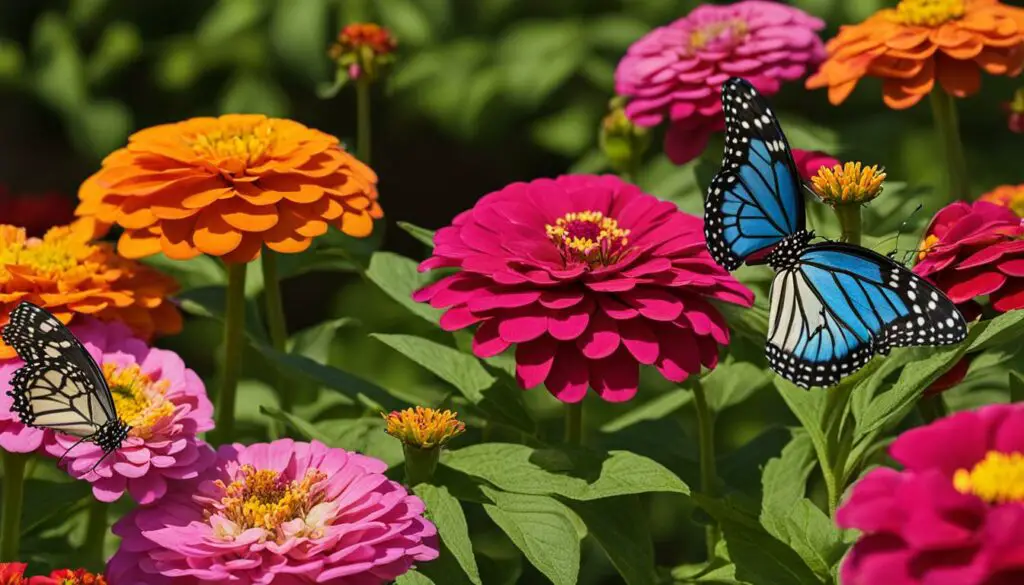
Joe Pye Weed (Eupatorium)
When it comes to attracting butterflies to your garden, Joe Pye weed is a standout choice. This tall perennial, with its clusters of dusty-pink flowers, is a favorite of large butterflies like swallowtails. Not only does it add beauty to your outdoor space, but it also provides a valuable food source for these magnificent creatures.
Growing Joe Pye weed is relatively easy, as it thrives in full sun and moist, well-drained soil. With its impressive height reaching over 6 feet, it creates a striking backdrop in a garden bed or as a focal point in a larger landscape. To enhance its allure, consider pairing Joe Pye weed with South American verbena. The combination of the dusty-pink blooms of Joe Pye weed and the vibrant purple flowers of verbena will create an irresistible haven for butterflies.
As with any plant, it’s always beneficial to choose companion plants that have similar growing conditions. By doing so, you ensure optimal health and beauty for your butterfly-friendly garden. So, if you’re looking to attract butterflies to your garden and add a touch of elegance, consider Joe Pye weed and its breathtaking dusty-pink flowers.
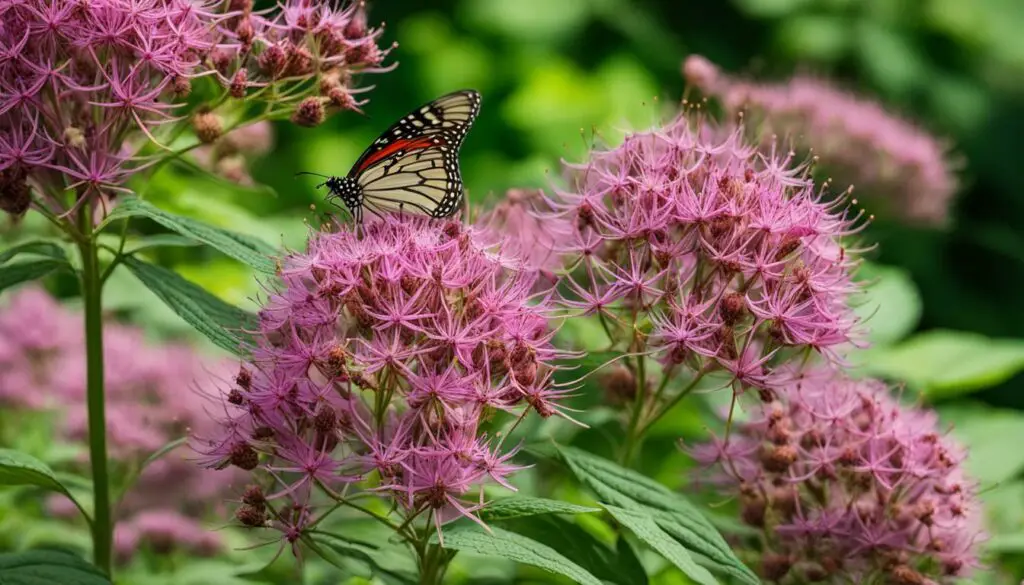
| Plant | Growing Conditions | Companion Plants | Flower Color |
|---|---|---|---|
| Joe Pye Weed (Eupatorium) | Full sun, moist, well-drained soil | South American Verbena | Dusty-pink |
Black-eyed Susan (Rudbeckia)
Black-eyed Susan, also known as Rudbeckia, is a stunning perennial that adds a burst of vibrant color to any garden. With its bright yellow daisy-shaped flowers, it is a favorite of both butterflies and humans alike. Black-eyed Susan can grow up to 6 feet in height and thrives in full sun and well-drained soil.
When it comes to companion plants, Black-eyed Susan pairs well with purple coneflower. The contrasting colors of the purple coneflower’s pinkish-purple blooms and the yellow flowers of the Black-eyed Susan create a visually striking combination. Both plants have similar growing conditions, making them a perfect match for a vibrant and cohesive garden design.
Black-eyed Susan is a low-maintenance plant that blooms from late summer through fall, providing a long-lasting source of nectar for butterflies. Its sturdy stems make it an excellent cut flower, allowing you to enjoy its beauty indoors as well. Incorporating Black-eyed Susan into your garden will not only attract butterflies but also add a touch of natural beauty to your outdoor space.
Growing Conditions for Black-eyed Susan (Rudbeckia)
| Plant Type | Perennial |
|---|---|
| Sun Exposure | Full sun |
| Soil Type | Well-drained |
| Height | Up to 6 feet |
| Companion Plants | Purple coneflower |
Include a visually engaging image related to Black-eyed Susan using the provided image link:
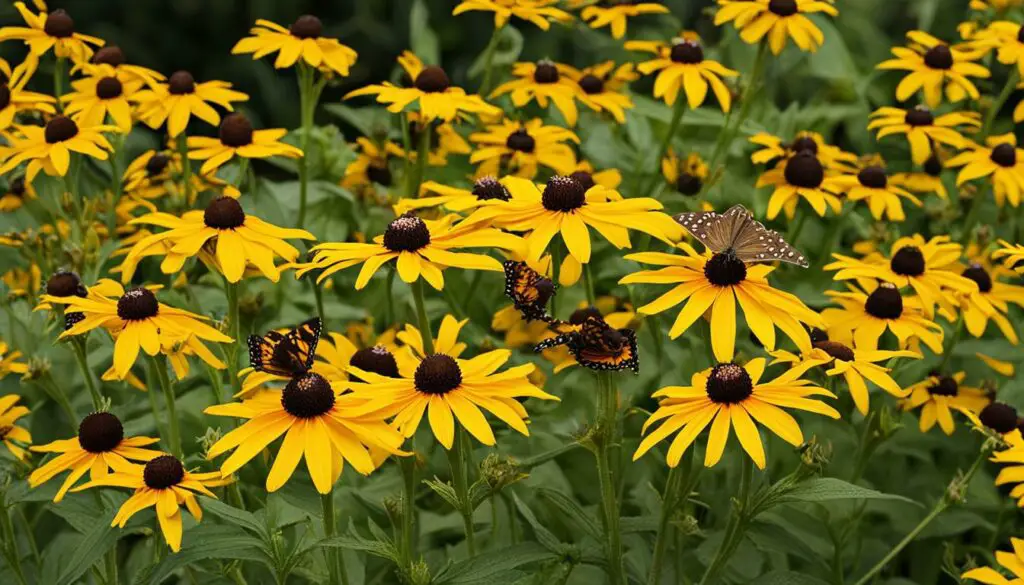
With its cheerful yellow flowers and ability to attract butterflies, Black-eyed Susan is a must-have for any butterfly garden. Its bright blooms and easy maintenance make it a popular choice among gardeners looking to create a beautiful and butterfly-friendly outdoor space.
Bronze Fennel (Foeniculum Vulgare)
One plant that can add both visual interest and attract Swallowtail butterflies to your garden is Bronze Fennel (Foeniculum Vulgare). This herbaceous perennial features feathery bronze foliage, adding texture and depth to your garden beds. Growing up to 6 feet in height, Bronze Fennel prefers full sun and moist, well-drained soil. Its delicate yellow flowers bloom in clusters during the summer, attracting not only butterflies but also beneficial insects like bees and ladybugs.
Companion plants that pair well with Bronze Fennel include Queen Anne’s Lace (Daucus carota), another plant that provides a similar texture and also serves as a host plant for Swallowtail caterpillars. Together, they create a visually pleasing combination that can support a thriving population of Swallowtail butterflies in your garden.
“Bronze Fennel is not only a beautiful addition to any garden but also a magnet for Swallowtail butterflies. Watching these graceful creatures flutter around the fennel plants is a true delight.” – Gardening Enthusiast
Growing Conditions for Bronze Fennel (Foeniculum Vulgare)
| Plant Name | Bronze Fennel (Foeniculum Vulgare) |
|---|---|
| Light Requirements | Full Sun |
| Soil Type | Moist, Well-Drained |
| Height | Up to 6 feet |
| Hardiness Zones | 4-9 |
With its attractive foliage, delicate flowers, and ability to attract Swallowtail butterflies, Bronze Fennel is a must-have addition to any butterfly garden. By providing a welcoming habitat for these beautiful creatures, you can enjoy the mesmerizing sight of Swallowtails gracefully dancing among the fennel plants.
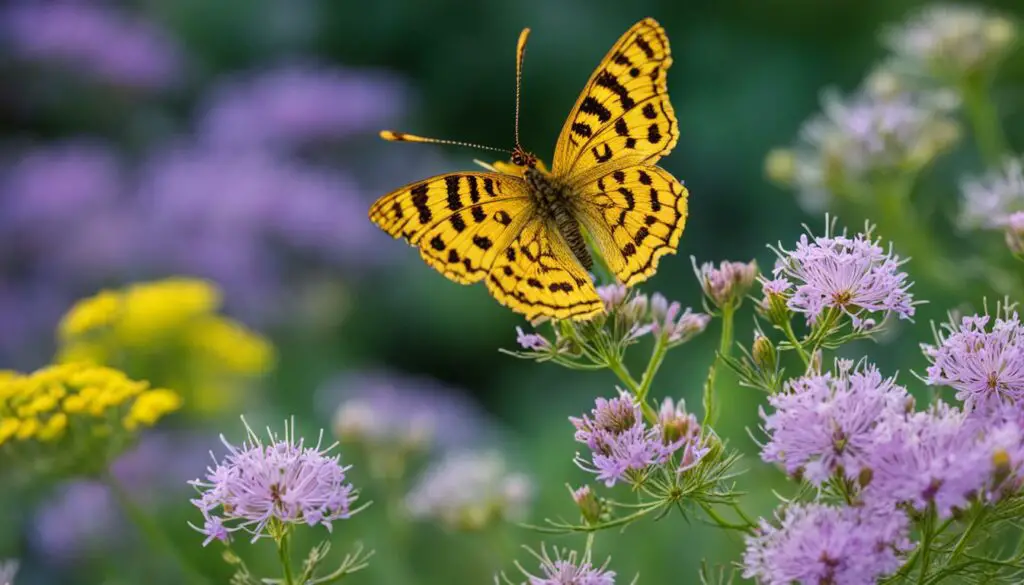
Coreopsis ‘Moonbeam’
Coreopsis ‘Moonbeam’ is a stunning perennial plant that adds a touch of sunshine to any garden. With its bright yellow flowers and delicate, ferny foliage, it is a favorite among both butterflies and garden enthusiasts. Growing this beautiful plant is relatively easy, making it a great addition to any garden.
To ensure the success of your Coreopsis ‘Moonbeam’, it is important to provide it with the right growing conditions. This plant thrives in full sun and well-drained soil. It can tolerate some dry spells, but regular watering is necessary during periods of drought. It is also important to note that ‘Moonbeam’ reaches a height of up to 18 inches, so it is best to give it some space to grow.
When it comes to companion plants, Coreopsis ‘Moonbeam’ pairs well with a variety of flowers. For a visually stunning combination, consider planting it alongside purple coneflower (Echinacea purpurea). The contrast of the yellow Coreopsis flowers against the purple coneflower blooms creates a beautiful and vibrant display.
One of the unique characteristics of Coreopsis ‘Moonbeam’ is its ability to re-bloom. By shearing the plant back after a flush of blooms starts to fade, you can encourage it to produce more flowers. This regular pruning will also help to keep the plant tidy and prevent it from becoming leggy. With proper care and maintenance, Coreopsis ‘Moonbeam’ will continue to provide you with a stunning display of yellow flowers throughout the summer.
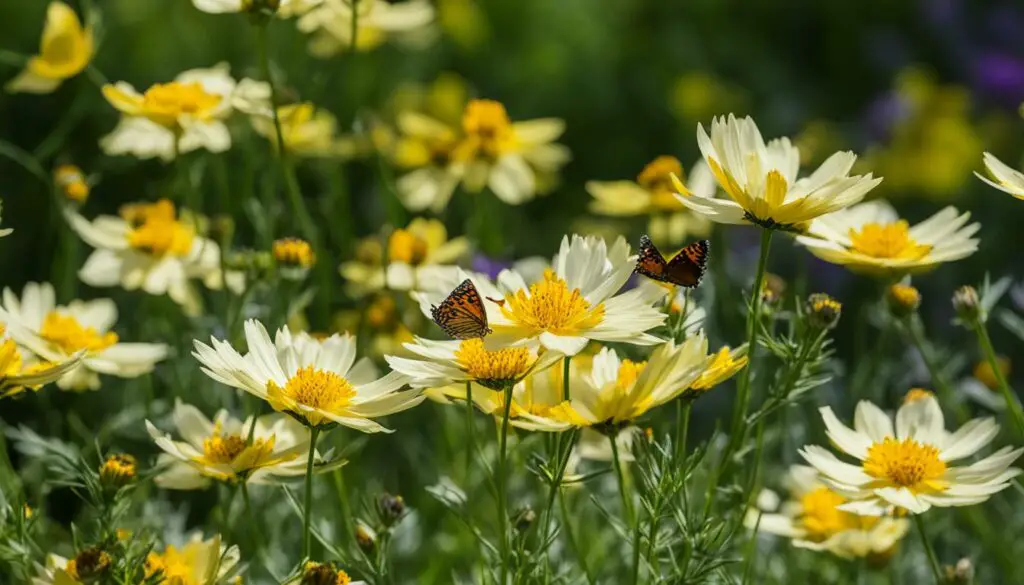
Coreopsis ‘Moonbeam’ Growing Conditions:
| Growing Conditions | Requirements |
|---|---|
| Sun Exposure | Full sun |
| Soil | Well-drained |
| Watering | Regular, especially during drought |
| Height | Up to 18 inches |
Whether you’re a butterfly enthusiast or simply want to add a splash of color to your garden, Coreopsis ‘Moonbeam’ is an excellent choice. Its yellow flowers and ferny foliage will attract butterflies and brighten up your outdoor space. By providing it with the right growing conditions, pairing it with complementary companion plants, and shearing it for re-blooming, you can enjoy the beauty of Coreopsis ‘Moonbeam’ throughout the summer.
Sedum ‘Frosted Fire’
When it comes to butterfly-friendly nectar plants, Sedum ‘Frosted Fire’ is a standout choice. This variety of Sedum, also known as Stonecrop, not only attracts butterflies but also adds a touch of color and texture to your garden. With its striking variegated leaves and clusters of small pink flowers, Sedum ‘Frosted Fire’ is a visually appealing addition to any butterfly garden.
Sedums are known for their ability to thrive in xeric conditions, making them an excellent choice for creating a butterfly garden that is low-maintenance and water-wise. With their succulent-like foliage, Sedums are incredibly drought-tolerant and can withstand hot and dry summers. This makes them a perfect fit for a xeric butterfly garden, where water conservation is a priority.
There are both tall and short varieties of Sedums available, allowing you to choose the one that best suits your garden design. The taller Sedums can reach heights of up to 2 feet, providing a dramatic backdrop to your butterfly garden. The shorter Sedums, on the other hand, are perfect for filling in gaps and adding pops of color throughout your garden.
To create an eye-catching combination, consider planting Sedum ‘Frosted Fire’ alongside other butterfly-friendly plants such as purple coneflower or liatris. These plants not only complement the colors and textures of Sedum ‘Frosted Fire’ but also attract a wide variety of butterfly species to your garden.
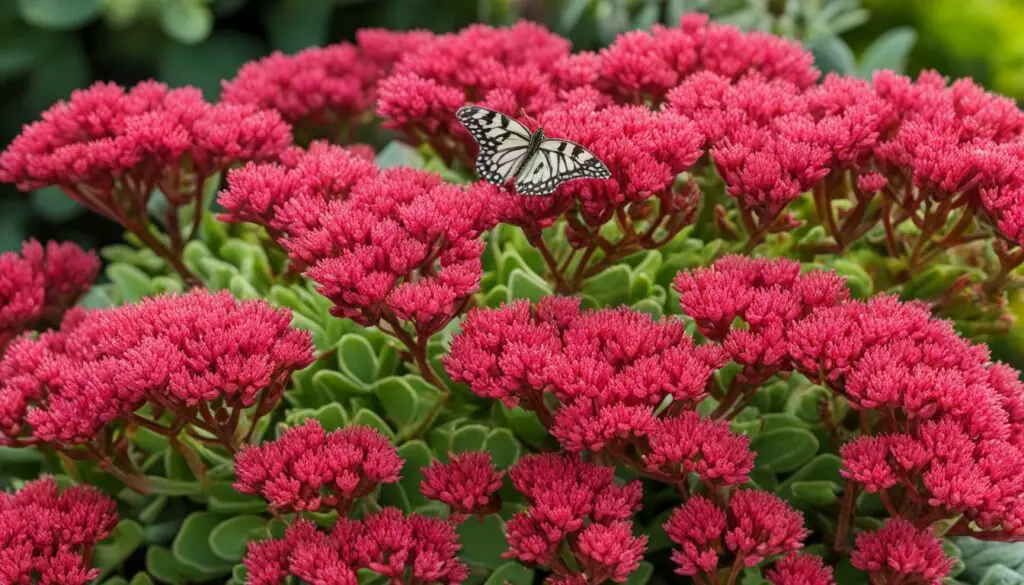
Conclusion
By incorporating these extraordinary butterfly-friendly nectar plants into your garden, you can create a haven for butterflies and enjoy the beauty of these winged pollinators up close. The butterfly bush, phlox paniculata, and black-eyed Susan are just a few of the plants that will attract a variety of butterfly species to your garden.
Creating a butterfly-friendly garden with nectar-rich plants is not only visually stunning but also a wonderful way to support these beautiful creatures and enhance the natural beauty of your outdoor space. Whether you’re a seasoned butterfly enthusiast or just starting out, attracting butterflies to your garden will provide endless enjoyment and a sense of wonder.
So, why wait? Get started on your butterfly garden today and watch as these magnificent insects dance and flutter among the colorful blooms. Create a haven for butterflies and experience the joy of witnessing their beauty in your own backyard.
FAQ
What are butterfly-friendly nectar plants?
Butterfly-friendly nectar plants are plants that attract butterflies with their flowers, providing a source of nectar for them to feed on.
Why should I create a butterfly-friendly garden?
Creating a butterfly-friendly garden allows you to support and enhance the natural beauty of these winged pollinators. It also provides an opportunity to enjoy the beauty of butterflies up close.
What growing conditions do butterfly-friendly plants prefer?
Butterfly-friendly plants generally prefer full sun and well-drained soil. However, specific growing conditions may vary depending on the plant species.
Which plants attract monarch butterflies?
Butterfly weed, or Asclepias tuberosa, is a must-have plant for attracting monarch butterflies. The adults drink nectar from its orange flowers, while the caterpillars feed on its leaves.
What are some companion plants that pair well with butterfly-friendly plants?
Some companion plants that pair well with butterfly-friendly plants include Mexican sunflower, purple coneflower, liatris, South American verbena, fennel, yarrow, bloody geranium, and Queen Anne’s lace.
Which plants are suitable for a fall butterfly garden?
Aster selections are top plants for a fall butterfly garden. They provide nectar for fall butterflies and serve as a food source for Pearl Crescent caterpillars.
How tall can butterfly-friendly plants grow?
The height of butterfly-friendly plants varies depending on the type. Some can reach up to 10 feet tall, while others stay shorter, around 18 inches.
What is the best way to encourage re-blooming in Coreopsis ‘Moonbeam’?
Shearing the plant back after a flush of blooms starts to fade encourages re-blooming in Coreopsis ‘Moonbeam.’
Which butterfly species are attracted to Sedum ‘Frosted Fire’?
Sedum ‘Frosted Fire’ attracts various butterfly species, including Fiery Skippers, Green Hairstreaks, Red Admirals, and Variegated Fritillaries.

